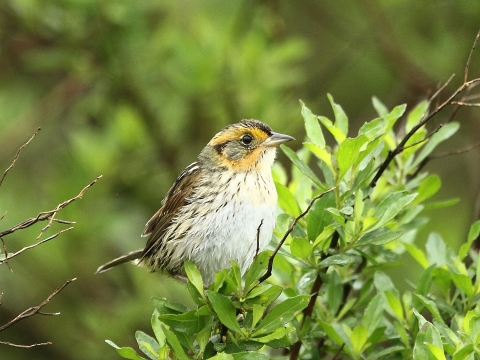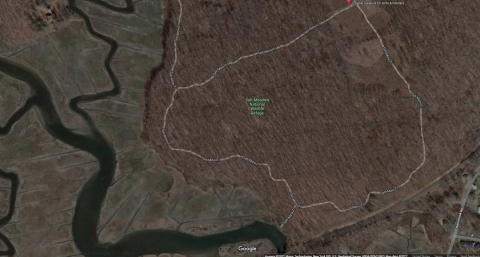You probably don’t care much about a saltmarsh sparrow. Chris Elphick, a conservation biologist who has dedicated most of his career to researching the small pale bird, doesn’t care much about an individual sparrow, either. He’s only partially joking.
For Elphick, the bird represents more than itself; it is a signifier of marsh health and a key to understanding the marsh ecosystem: how it is changing and how to help it adapt to outside influences.
“We don't just do this [research] because we're interested in sparrows—of course we are interested in sparrows—but it has a lot of other repercussions across salt marshes that I think are important,” said Elphick.
It’s part of why the species and the marsh habitat they live in have become a priority for the U.S. Fish and Wildlife Service. Protecting sparrow habitat in turn benefits marsh soil and water systems, the health of other marsh plants and animals, and even humans who live around the marshes. In addition to the recreational value a healthy marsh offers hunters, anglers, and birdwatchers, these natural sponges can act as essential buffers to storm surge. With a rich peat foundation, healthy marshes can sequester massive amounts of carbon—with the potential to mitigate some effects of climate change climate change
Climate change includes both global warming driven by human-induced emissions of greenhouse gases and the resulting large-scale shifts in weather patterns. Though there have been previous periods of climatic change, since the mid-20th century humans have had an unprecedented impact on Earth's climate system and caused change on a global scale.
Learn more about climate change .
“In my mind, at least,” Elphick said, “saltmarsh sparrows are [part of] this chain, and they're telling us what's going to happen in the future to other species. Trying to figure out what's going on with saltmarsh sparrows will better help us think about what we can do for those other species.”
Right now, the signal the sparrows are sending says that a changing climate puts marshes—and their avian dwellers—in trouble.
Marshes and sparrows under climate change
A salt marsh salt marsh
Salt marshes are found in tidal areas near the coast, where freshwater mixes with saltwater.
Learn more about salt marsh should act like a sponge, absorbing tidal flow into its dense peat layer, which filters toxins and slowly releases unpolluted water through a series of natural streams and channels.
Recently, however, most East Coast marshes look more like plates left in the kitchen sink, with water pooling in pockets on the surface. A history of human diking and ditching has interrupted the natural tidal flow and prevented the build-up of plants and sediment that keeps the marsh surface above the tide.
Rising sea levels, due to climate change, present an even more daunting threat to these deteriorating landscapes. Across the Eastern Seaboard, salt marshes are sinking.
Imagine what that means for the tiny 20 gram bird that builds its nest right above the high-tide mark, in a healthy marsh. Countless saltmarsh sparrow nests have been flooded as tides come in higher and higher, and suitable nesting habitat is harder to find due to standing water pools and sub-par marsh vegetation.
When sparrows lose their nests to flooding, they often rebuild higher in the marsh, which leaves them more exposed and vulnerable to predators. Flooding and predation are the primary reasons saltmarsh sparrow nests fail at such high rates. Researchers estimate that the saltmarsh sparrow has lost over 70% of its population in the last 15 years; that number could be 100% in the next 50 if conservationists don’t act quickly to help marshes keep up.
“You can’t have saltmarsh sparrows without salt marshes, so when sparrows start declining, it is an indicator for overall marsh health and an indicator that other marsh species are experiencing similar problems,” said Bri Benvenuti, the regional biologist for Ducks Unlimited Inc., New England and former biological technician at Rachel Carson National Wildlife Refuge. “Asking these specific questions about the saltmarsh sparrow helps us drive these larger questions we can ask about marsh health,” she added.
Small mounds with the potential for greatness
Connecticut’s Great Meadows Marsh is one site where managers are seeking answers to questions about marsh health and sparrow populations. The marsh lies within the Stewart B. McKinney National Wildlife Refuge.
The Service, Audubon Connecticut, Connecticut Department of Energy and Environmental Protection, and National Oceanic and Atmospheric Administration restored over 30 acres of the marsh through a $4 million project—with additional funding from the Environmental Protection Agency and The Nature Conservancy, among others.
With relatively few nesting sparrows, the site proved the perfect spot to test new restoration techniques.
Most of the work, which began in October 2021, focused on restoring salt marsh habitat through more established techniques to improve hydrology and increase elevation, like removing berms and digging more than 2,000 linear feet of tidal channels.
But, in a 4-acre patch where sparrows currently nest, managers saw both the need and opportunity to do something different.
“We didn’t want to disturb any nesting birds, but we also were seeing this area rapidly transitioning away from high marsh, and most of the nests out here failed due to flooding,” said Suzanne Paton, wildlife biologist with the Service’s Ecological Services Southern New England Coastal Program who supported the restoration project.
Paton and the rest of the team decided to build “little islands of higher elevation,” called hummocks. The idea was to create patches of good habitat that mimicked healthy high marsh around existing nesting areas.
Crews identified the lowest sections of marsh and placed sediment—over a foot high in places—to bring the elevation back to high-marsh levels. Then, teams planted vegetation, experimenting with spacing and species in each plot. They hope to learn about how sparrows are using the marsh and responding to changes. A ribbon-cutting ceremony on August 30 marked the official conclusion of the restoration work to return the site to a healthy marsh that can, in time, become prime saltmarsh sparrow nesting habitat.
Keeping an eye on the sparrow
This is where Elphick and his doctoral student, Franco Gigliotti, come in. They are using the restoration site to gather data for their research at the University of Connecticut. Gigliotti spent his summer in the marsh, monitoring sparrow nests and watching how the birds used the recently restored space.
“We want to learn how birds respond to disturbance [from restoration construction] in their nesting area,” Paton said. “As we’re trying to make the marsh more resilient to climate change through these projects, we’re trying to figure out just how resilient the birds are. How stressed out are they? Will they come back to nest there if we go in to do that restoration work?”
At year one, few answers are clear. Gigliotti saw curious birds foraging on the hummocks, but it’s not quite suitable nesting habitat yet – exactly what they predicted for this point. Almost every nest failed this year, nearly all due to flooding, which is also what they expected: “That level of failure is what we see on nearly every site where we study these birds, so it's not just a Great Meadows Marsh thing, and that's true even in our ‘good’ sites too,” Gigliotti said.
It’s a stark reality that underscores how much marsh ecosystems are crumbling without proper hydrology. Climate change is now adding to the intense strain past alterations have put on marsh processes.
“Saltmarsh sparrows are just one 'Jenga®' piece in our marsh 'Jenga®' tower, to co-opt a metaphor I’ve heard,” Gigliotti said. “Losing some saltmarsh sparrows may not look like a lot to some people if they don't care too much about them, but, you know, as we lose these different species in the marsh, it kind of gives us a weaker ecosystem that's more prone to collapse. And, you know, if this whole system does collapse, we see conversion of salt marshes to completely different habitats, like mud flats or open water.”
The researchers accept that climate change is going to alter some salt marshes irreversibly, but they hope restorations like the one at Great Meadows Marsh can be lifelines for sparrows and marshes, countering the harm humans have caused, either directly through mismanagement or indirectly through greenhouse gas emissions.
They speculate that the right interventions can be the boost marshes need to get past current challenges. From there, natural processes can take hold, making the marshes inherently more resilient to rising sea levels and storms, protecting the sparrows and nearby communities.
Putting climate change into context for people and sparrows
The sparrows can be the “canaries in the salt marsh” and the keys to assessing restoration techniques.
“Collecting data over the next few years is really going to give us the information we need to understand if the restoration as it was carried out is going to be beneficial for the sparrows and how they're actually responding to those hummocks revegetating over time,” Gigliotti said.
It will help on two scales: the hyper-specific, which will reveal how birds navigate through the marsh, and the marsh-level, to see how the landscape itself changes and responds.
Seeing how marsh ecology is changing will help researchers understand which marsh processes we may be losing.
Said Elphick, “You know, these marshes provide all kinds of services for people that are very important”—things like storm-surge protection, water filtration, and carbon sequestration—“so understanding how the marshes are changing and how our management will affect those changes is pretty important for understanding all of those other things that we care about.”
And to gain that understanding, informing humans’ battle against sea-level rise and climate change, researchers will need to take cues from the small bird these efforts can, in turn, protect.
“It’s the saltmarsh sparrows, who are on the front lines. They are facing climate change head on,” said Paton.






